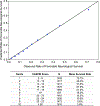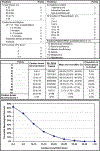Using risk prediction tools in survivors of in-hospital cardiac arrest
- PMID: 24464303
- PMCID: PMC10756641
- DOI: 10.1007/s11886-013-0457-0
Using risk prediction tools in survivors of in-hospital cardiac arrest
Abstract
In-hospital cardiac arrests are common and associated with poor outcomes. Predicting the likelihood of favorable neurological survival following resuscitation from an in-hospital cardiac arrest could provide important information for physicians and families. In this article, we review the literature regarding predictors of survival following in-hospital cardiac arrest. Specifically, we describe the Cardiac Arrest Survival Postresuscitation In-hospital (CASPRI) score that was recently developed and validated using data from the Get With the Guidelines-Resuscitation registry. The CASPRI score includes 11 predictor variables: age, initial cardiac arrest rhythm, defibrillation time, baseline neurological status, duration of resuscitation, mechanical ventilation, renal insufficiency, hepatic insufficiency, sepsis, malignancy, and hypotension. The score is simple to use at the bedside, has excellent discrimination and calibration, and provides robust estimates of the probability of favorable neurological survival after an in-hospital cardiac arrest. Thus, CASPRI may be valuable in establishing expectations by physicians and families in the critical period after these high-risk events.
Conflict of interest statement
Compliance with Ethics Guidelines
Brahmajee K. Nallamothu declares that he has no conflict of interest.
Paul S. Chan has been a consultant for Optum Rx and American Heart Association.
Figures


Similar articles
-
Validation of CASPRI, GO-FAR, PIHCA scores in predicting favorable neurological outcomes after in-hospital cardiac arrest; A five-year three center retrospective study in IRAN.BMC Cardiovasc Disord. 2024 Oct 29;24(1):603. doi: 10.1186/s12872-024-04229-8. BMC Cardiovasc Disord. 2024. PMID: 39472823 Free PMC article.
-
A validated prediction tool for initial survivors of in-hospital cardiac arrest.Arch Intern Med. 2012 Jun 25;172(12):947-53. doi: 10.1001/archinternmed.2012.2050. Arch Intern Med. 2012. PMID: 22641228 Free PMC article.
-
Duration of cardiopulmonary resuscitation and illness category impact survival and neurologic outcomes for in-hospital pediatric cardiac arrests.Circulation. 2013 Jan 29;127(4):442-51. doi: 10.1161/CIRCULATIONAHA.112.125625. Epub 2013 Jan 22. Circulation. 2013. PMID: 23339874
-
Cardiac arrest and cardiopulmonary resuscitation outcome reports: update of the Utstein Resuscitation Registry Templates for Out-of-Hospital Cardiac Arrest: a statement for healthcare professionals from a task force of the International Liaison Committee on Resuscitation (American Heart Association, European Resuscitation Council, Australian and New Zealand Council on Resuscitation, Heart and Stroke Foundation of Canada, InterAmerican Heart Foundation, Resuscitation Council of Southern Africa, Resuscitation Council of Asia); and the American Heart Association Emergency Cardiovascular Care Committee and the Council on Cardiopulmonary, Critical Care, Perioperative and Resuscitation.Circulation. 2015 Sep 29;132(13):1286-300. doi: 10.1161/CIR.0000000000000144. Epub 2014 Nov 11. Circulation. 2015. PMID: 25391522
-
Mechanical versus manual chest compressions for cardiac arrest.Cochrane Database Syst Rev. 2018 Aug 20;8(8):CD007260. doi: 10.1002/14651858.CD007260.pub4. Cochrane Database Syst Rev. 2018. PMID: 30125048 Free PMC article.
Cited by
-
In Hospitals With More Nurses Who Have Baccalaureate Degrees, Better Outcomes For Patients After Cardiac Arrest.Health Aff (Millwood). 2019 Jul;38(7):1087-1094. doi: 10.1377/hlthaff.2018.05064. Health Aff (Millwood). 2019. PMID: 31260358 Free PMC article.
-
Survival after in-hospital cardiac arrest among cerebrovascular disease patients.J Clin Neurosci. 2018 Aug;54:1-6. doi: 10.1016/j.jocn.2018.04.033. Epub 2018 May 19. J Clin Neurosci. 2018. PMID: 29789199 Free PMC article.
-
Predicting in-hospital mortality for initial survivors of acute respiratory compromise (ARC) events: Development and validation of the ARC Score.Resuscitation. 2017 Jun;115:5-10. doi: 10.1016/j.resuscitation.2017.02.022. Epub 2017 Mar 4. Resuscitation. 2017. PMID: 28267618 Free PMC article.
-
Prediction model of in-hospital cardiac arrest using machine learning in the early phase of hospitalization.Kaohsiung J Med Sci. 2024 Nov;40(11):1029-1035. doi: 10.1002/kjm2.12895. Epub 2024 Sep 25. Kaohsiung J Med Sci. 2024. PMID: 39319603 Free PMC article.
-
Validation of CASPRI, GO-FAR, PIHCA scores in predicting favorable neurological outcomes after in-hospital cardiac arrest; A five-year three center retrospective study in IRAN.BMC Cardiovasc Disord. 2024 Oct 29;24(1):603. doi: 10.1186/s12872-024-04229-8. BMC Cardiovasc Disord. 2024. PMID: 39472823 Free PMC article.
References
-
- Kazaure HS, Roman SA, Sosa JA. Epidemiology and Outcomes of In-Hospital Cardiopulmonary Resuscitation in the United States, 2000–2009. Resuscitation 2013;84:1255–60. - PubMed
-
- •• Girotra S, Nallamothu BK, Spertus JA, Li Y, Krumholz HM, Chan PS. Trends in survival after in-hospital cardiac arrest. N Engl J Med 2012;367:1912–20. This study describes temporal trends in survival and neurological outcomes among in-hospital cardiac arrest victims during the past decade.. - PMC - PubMed
-
- Nadkarni VM, Larkin GL, Peberdy MA, et al. First documented rhythm and clinical outcome from in-hospital cardiac arrest among children and adults. JAMA 2006;295:50–7. - PubMed
Publication types
MeSH terms
Grants and funding
LinkOut - more resources
Full Text Sources
Other Literature Sources
Medical

